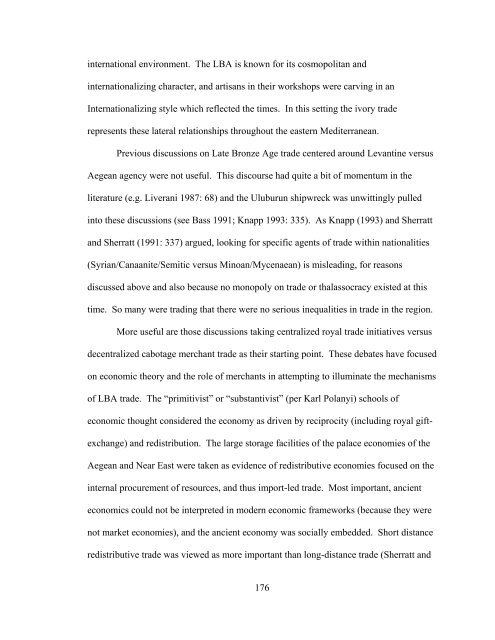Tracing the Source of the Elephant And Hippopotamus Ivory from ...
Tracing the Source of the Elephant And Hippopotamus Ivory from ...
Tracing the Source of the Elephant And Hippopotamus Ivory from ...
Create successful ePaper yourself
Turn your PDF publications into a flip-book with our unique Google optimized e-Paper software.
international environment. The LBA is known for its cosmopolitan and<br />
internationalizing character, and artisans in <strong>the</strong>ir workshops were carving in an<br />
Internationalizing style which reflected <strong>the</strong> times. In this setting <strong>the</strong> ivory trade<br />
represents <strong>the</strong>se lateral relationships throughout <strong>the</strong> eastern Mediterranean.<br />
Previous discussions on Late Bronze Age trade centered around Levantine versus<br />
Aegean agency were not useful. This discourse had quite a bit <strong>of</strong> momentum in <strong>the</strong><br />
literature (e.g. Liverani 1987: 68) and <strong>the</strong> Uluburun shipwreck was unwittingly pulled<br />
into <strong>the</strong>se discussions (see Bass 1991; Knapp 1993: 335). As Knapp (1993) and Sherratt<br />
and Sherratt (1991: 337) argued, looking for specific agents <strong>of</strong> trade within nationalities<br />
(Syrian/Canaanite/Semitic versus Minoan/Mycenaean) is misleading, for reasons<br />
discussed above and also because no monopoly on trade or thalassocracy existed at this<br />
time. So many were trading that <strong>the</strong>re were no serious inequalities in trade in <strong>the</strong> region.<br />
More useful are those discussions taking centralized royal trade initiatives versus<br />
decentralized cabotage merchant trade as <strong>the</strong>ir starting point. These debates have focused<br />
on economic <strong>the</strong>ory and <strong>the</strong> role <strong>of</strong> merchants in attempting to illuminate <strong>the</strong> mechanisms<br />
<strong>of</strong> LBA trade. The “primitivist” or “substantivist” (per Karl Polanyi) schools <strong>of</strong><br />
economic thought considered <strong>the</strong> economy as driven by reciprocity (including royal gift-<br />
exchange) and redistribution. The large storage facilities <strong>of</strong> <strong>the</strong> palace economies <strong>of</strong> <strong>the</strong><br />
Aegean and Near East were taken as evidence <strong>of</strong> redistributive economies focused on <strong>the</strong><br />
internal procurement <strong>of</strong> resources, and thus import-led trade. Most important, ancient<br />
economics could not be interpreted in modern economic frameworks (because <strong>the</strong>y were<br />
not market economies), and <strong>the</strong> ancient economy was socially embedded. Short distance<br />
redistributive trade was viewed as more important than long-distance trade (Sherratt and<br />
176

















